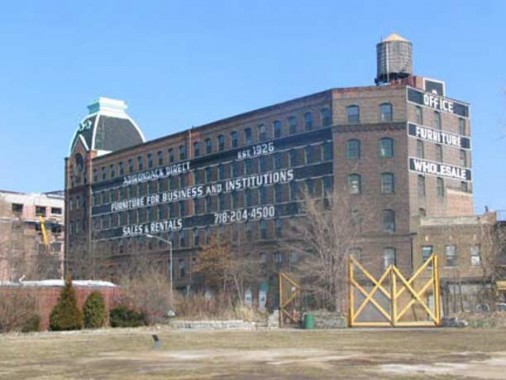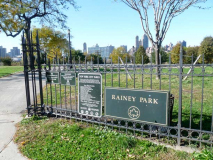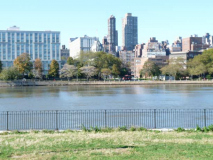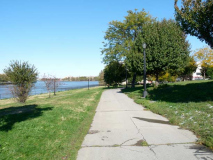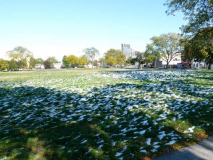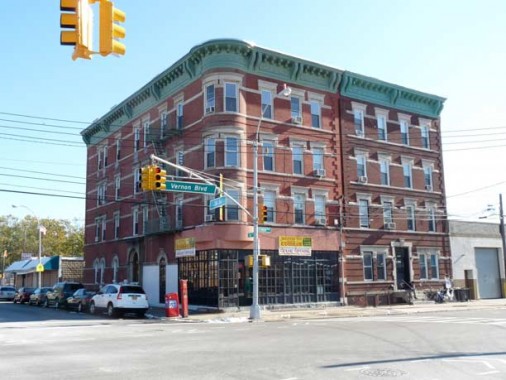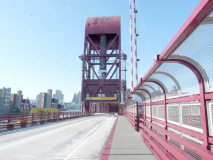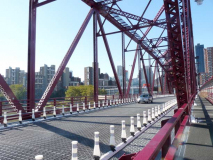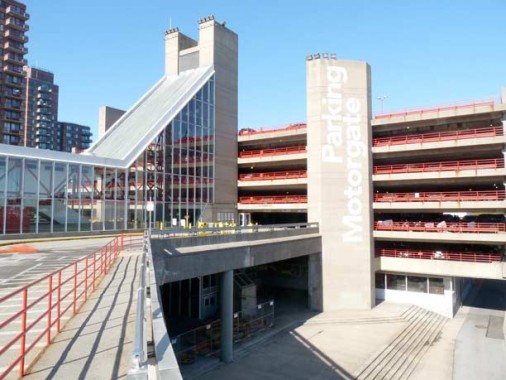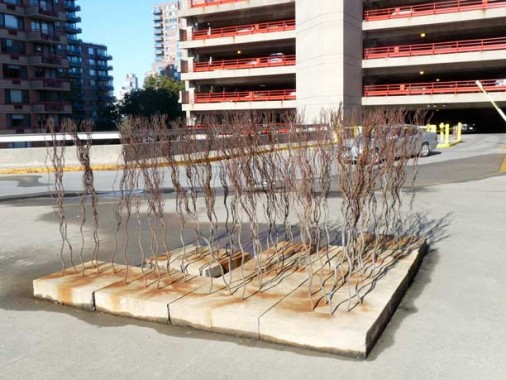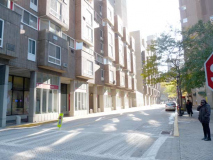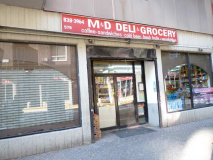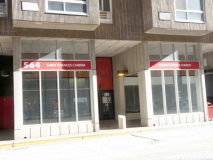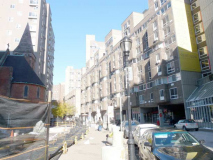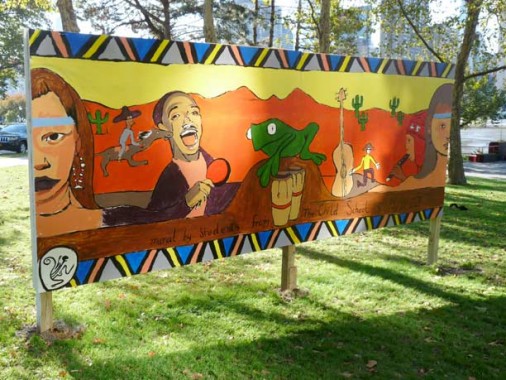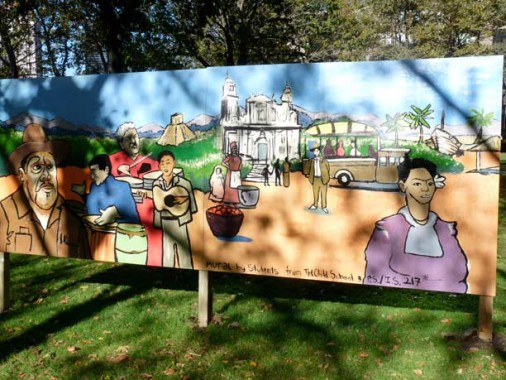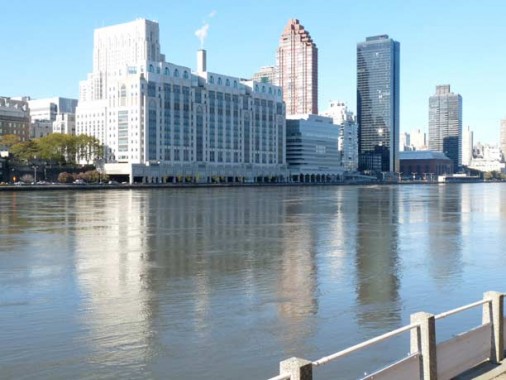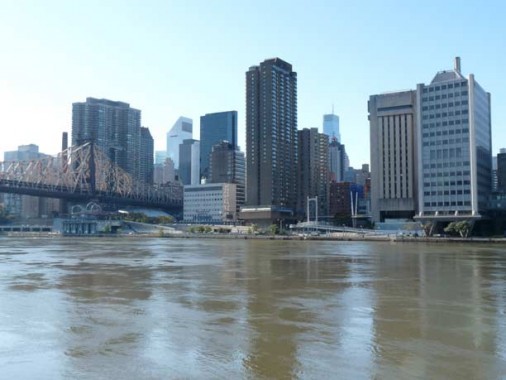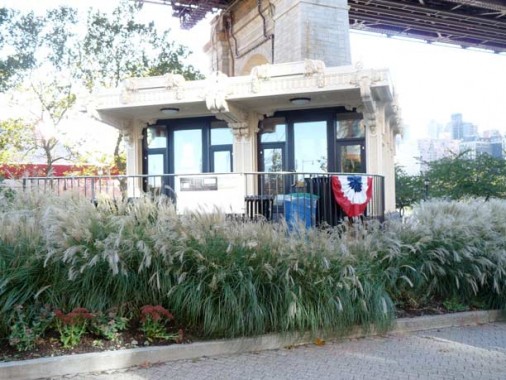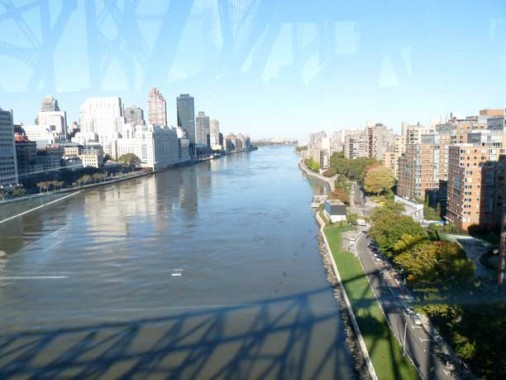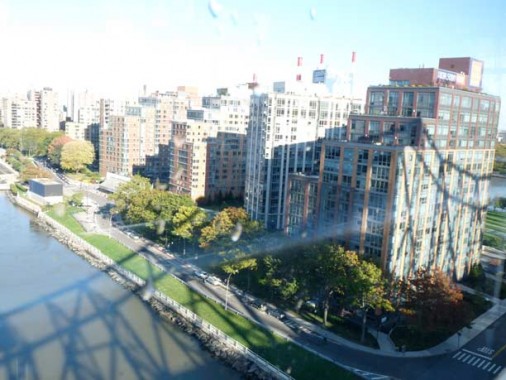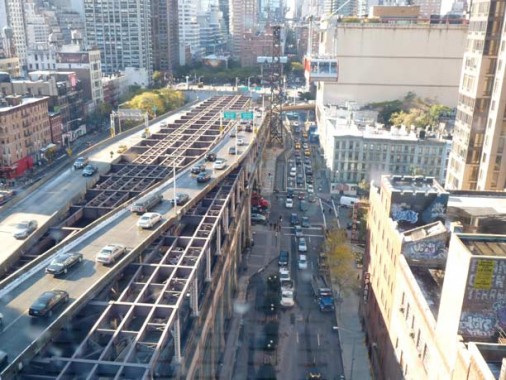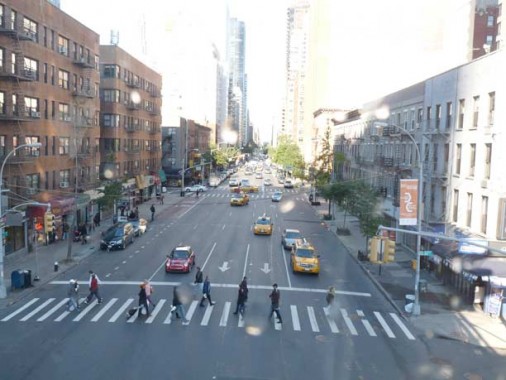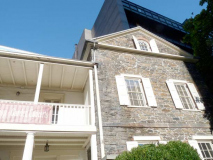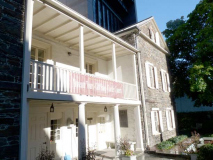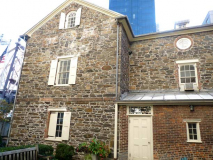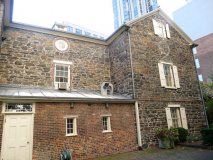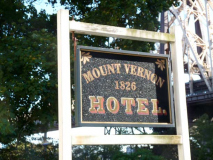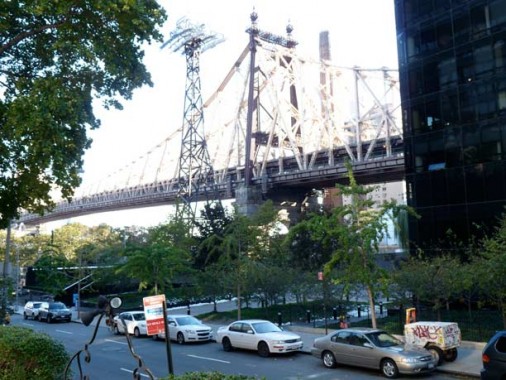I set out to walk from the Astoria Boulevard BMT elevated station to the Mount Vernon “Hotel” in Lenox Hill on October 30, 2011, a bright fall day that was the first day following NY’s heaviest snowstorm of the winter, as it has likely turned out. On October 29th, parts of the city got 6 inches, while other parts got none at all; howls of those expecting a new ice age were heard, but as it turned out it was the mildest winter in years, with 45-50 degrees each day the rule, and only one other measurable snowfall. I am writing this at the end of February, but I’ll be pretty surprised if any blizzards hit in March…
GOOGLE MAP: ASTORIA to LENOX HILL
The changing exhibits, such as Darren Goins‘ “Salad Days” at Socrates Sculpture Park, between Vernon Boulevard and Hallets Cove/East River from 31st Avenue to Broadway, always make it a good place to kill a half hour. Socrates was a dumpsite until it was “rescued” in 1986 by a coalition of artists/activists headed by Mark di Suvero. It now works both as an outdoor workshop for aspiring artists and as a waterside park.
What was constructed as the Sohmer Piano factory at 31st Avenue and Vernon Boulevard in 1887 became, 95 years later, the headquarters/showrooms of the Adirondack Furniture Company — this photo was taken when the signs were still painted on the exterior brickwork. The building, after an uncertain period, was converted to rental residences, some of which have enviable views of the river, Roosevelt Island and Manhattan.
Rainey Park
The Queens East River bank features a number of parks –some newly created (over the last 20 years or so) such as Socrates Sculpture Park and Gantry State Park in Hunters Point, and some that have been there for decades yet only locals know about, such as Rainey Park and Queensbridge Park.
Rainey Park is named for a local Ravenswooder who advocated for an East River bridge connecting Queens and Manhattan:
Dr. Thomas Rainey (1824-1910), a resident of Ravenswood, Queens, spent 25 years of his life and most of his fortune advancing the construction of a bridge across the East River between Manhattan and Long Island City. The area that now accommodates Rainey Park was to be the Queens anchor for the “Blackwell Island Bridge,” a project backed by leading citizens of Long Island City after the American Civil War. In 1871, they incorporated the “New York and Queens County Bridge Company.” The bridge, planned with one ramp south to Brooklyn and another out to Long Island, was promoted as a catalyst for developing growth in Queens and as a railroad link to Long Island. To the community’s disadvantage, the effort fell apart during the financial Panic of 1873. NYC Parks
Apartment building at Vernon Boulevard and 36th Avenue, which faces the only vehicular gateway to Roosevelt Island:
Though Roosevelt Island is technically a part of Manhattan, between 1958 and 1976 the only way to get there was by a bridge at 36th Avenue and Vernon Blvd. in Astoria, Queens. (Before 1958 a trolley would let you off on the Queensboro Bridge, where an elevator would transport you to the island.) The bridge is still the only way to get there by car or bus. Since 1976, the only tramway in NYC (see below) has run from Second Avenue and 60th Street, and subway service was initiated in 1989. The lift bridge (the roadway is relatively rarely raised to allow East River shipping to pass) was opened in 1955 and was originally called the Welfare Island Bridge; the island has had three names in English: Blackwell’s Island; Welfare Island (it was mostly used for asylums, hospitals and institutions until the 1970s) and finally, Roosevelt Island, after Franklin Delano Roosevelt.
The Moorgate Parking Garage was opened in 1974 while island housing was still under construction. Residents are encouraged to park here instead of using the island’s relatively sparse roads. Some very rusty public art can be found outside. A supermarket is on the ground level.
On Main Street
All five boroughs have a Main Street and a Broadway — Queens’ Main Street is the busiest Main, and all Broadways are major. Manhattan’s Main Street runs for most of the spine of Roosevelt Island. The residential buildings on the island are fairly bland, but oddly appealing–most store signage is red and white, and all the sidewalks are covered, giving the apartment buildings the appearance of hanging over the roadway.
Various plans for park and residential development on Roosevelt Island which would include a subway connection began to circulate in the 1960s. Finally, a plan envisioned by legendary architect Philip Johnson and John Burgee was decided upon. The Urban Development Corporation, inaugurated in 1969, hired developers and construction began. Roosevelt Island was built up with high rise developments and a promenade on the eastern and western sides of the island.
NYC has a number of isolated island developments. In addition to Roosevelt Island there are relatively isolated communities on Broad Channel, Queens, and City Island, Bronx.
A pair of murals painted by students in Roosevelt Island schools.
The island affords a view of the NY Hospital Cornell Medical Center, at the east end of East 68th Street, originally built in 1933 and expanded since. Part of it sits atop the FDR Drive.
In October NY riverways were still colored reddish brown, courtesy upstate runoff from Hurricane Irene in August 2011, which caused widespread damage upstate and in New England.
At the tramway entrance, there’s been a new addition: one of the ornate entrance/exit kiosks formerly found at 2nd Avenue Queensboro Bridge traffic funnel, now serving as a visitor center. There were four of these that served as entrances and exits to the trolley line that worked the bridge. For several years, this one served as the entrance gate for the Brooklyn Children’s Museum in Bedford-Stuyvesant, Brooklyn before a reconstruction forced it out. One of the kiosks has remained, almost by default, at 2nd Avenue.
I had just missed the tram, but that gave me a chance to see it leaving, ascending high over the river.
The Tramway is managed by Interfac, a division of JWP on behalf of the Roosevelt Island Operating Corporation of the State of New York (“RIOC”). RIOC is a state public benefit corporation created in 1984 to run the island’s services and complete the island’s development.
The Tramway is unique as the only aerial commuter tram in the United States. It was designed by Vonroll of Switzerland and travels a distance of 3,100 feet. Since it actually rises above the slightly off-parallel Queensboro Bridge, it provides excellent views of that structure, as well as panoramic views of the surrounding area for miles, but note: the trip takes just over four minutes. For several years after the subways switched over to farecards, entering the tram was still done by placing tokens in turnstiles. The Roosevelt Island Operating Corporation had never reached an agreement with the MTA to install farecard machines, which first started appearing in 1994. As a result, the tramway was the token’s last redoubt.
Farecards were finally instituted in 2004.
The tram rises to a maximum height of 250 feet above the East River and the trip is 10 minutes, or 5 in each direction. The cars can hold up to 115 people.
A final glimpse of the Roosevelt Island high-rises.
There are two campuses, or complexes, in Manhattan founded by the Rockefeller family. Looking north from the tram along the East River western shore is the Rockefeller University campus, with the high-rise Scholars Building (1988) seen here in the middle. To its right is one of the two cable-stayed pedestrian bridges in NYC; the other one spans 46th Street over 12th Avenue at the Intrepid Museum.
The inscrutable, 2001: A Space Odyssey-esque monolith on the right is #1 Sutton Place North, where even after a 4-year recession, rental prices are still astronomical in 2012. Here at the apex of the tram voyage we are a little higher than the Queensboro Bridge tower. On the left you can see the 55-story, 805-foot tall Bloomberg Tower at 731 Lexington Avenue and East 58th Street, the home of the Bloomberg financial news service founded by the future mayor, which has luxury condominiums above the 31st floor.
Getting closer to the ground, a glimpse of the Queensboro Bridge approach ramp. Until 1942, the bridge supported a spur of the 2nd Avenue El bound for Queensboro Plaza, and trolley lines also linked the boroughs How convenient it would be today if N, Q and 7 trains could transfer to an East Side el line. Transportation convenience was traded for esthetic value and real estate assessment, as well as made room for the ascendance of King Auto.
Just before touching down, across 2nd Avenue. Until the 1980s, the stretch of 2nd Avenue in the Queensboro Bridge vicinity was still paved with Belgian blocks. This situation may have inspired Paul Simon’s “kickin down the cobblestones” line in “Feelin’ Groovy.” If I ever meet him in an elevator, I’ll ask him.
Mount Vernon “Hotel”
After getting off the tram I headed east on East 61st Street to one of the oldest buildings in the area, the Abigail Adams Museum, alternately the Mount Vernon Hotel. It’s fairly difficult to photograph on sunny days, as it is surrounded by tall buildings that cast their shadows on it.
From the ForgottenBook:
The stone building with the two-level white porch on East 61st Street west of York Avenue doesn’t quite parallel the street it’s on, and seems to carry an air of faded dignity and separatedness from the surrounding structures. It is the remnant of an estate purchased in 1796 by William Stephen Smith and his wife Abigail, the daughter of President John Adams. The main mansion was lost in an 1826 fire, while the carriage house, the building that remains today, was employed as lodging for northerly travelers and people wishing a day in the country between 1826 and 1833. The hotel closed that year after only about seven years of operation.
The house remained in private hands until 1924, when it was purchased by the Colonial Dames of America, refitted with historical effects and rechristened as a museum in 1939. Presently, the house is open to the public and offers a fascinating look at when its surrounding area was considered a respite from the madding crowd. On display you will find a tea set owned by John Adams, a Louis Philippe crystal chandelier, playing cards (without numbers, in an era when just a small percentage of the population could read) and kids’ toys from the 19th Century, a French barrel organ, quill pens and spittoons. There is a quiet outdoor patio out back. Call (212) 838-6878, or visit www.mvhm.org.
Unless you know where you have been, you will never know where you’re going. It helps, anyway.
2/28/12



